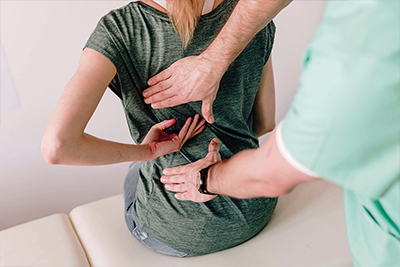Back pain comes in many forms. Some incidences of back pain may appear after a traumatic event while others can happen without a known cause. Regardless of type, back pain can range from mild lower back discomfort to excruciating symptoms of sciatica.
Types of Back Pain
Back pain can also be acute or chronic. Acute back pain happens without warning. Symptoms can be mild in onset to debilitating, preventing you from performing activities of daily living.
Back pain is classified as chronic when the symptoms exist for prolonged periods of time. This is seen most frequently in cases of degenerative disc disease and sciatica.
What Is Sciatica?
Sciatica is a medical condition in which person experiences pain and discomfort in their sciatic nerve. The sciatic nerve is located in the lower back and courses through the hip area, to the buttocks and finally down both legs.
In most cases, this condition generally affects only one side of the lower body. However, some people may have bilateral sciatic symptoms, in which where both sides are affected.
Pain intensity does vary, but the most common form is often described as a sharp and aching pain. Some people may only experience a dull ache, while others have burning or excruciating pain, preventing them from sitting and walking comfortably.
Causes of Sciatica
Sciatica is caused when the sciatic nerve is pinched. Disc herniations are the leading cause of sciatica. In addition, bone spurs impinging on the sciatic nerve can also cause painful symptoms, as can the natural ageing process.
Other causes of sciatica may include:
Pregnancy
Pregnancy can cause sciatica due to the influx of hormones such as relaxin. Relaxin is a hormone that’s only produced during pregnancy. This hormone is responsible for causing a woman’s ligaments, which are what connects the joints to the bones, to stretch out. The added weight of the baby also causes excessive pressure on the woman’s hip joints and sciatic nerve.
Degenerative disk disease
DJD is a medical condition that affects the disks within the spinal canal. Over time, the disks gradually begin to disintegrate, breaks down the cushioning in between the vertebrae. If a disc starts to degenerate in the lumbar spine, it may cause sciatica as a symptom.
Lumbar spinal stenosis
Spinal stenosis occurs when the spinal canal starts to narrow in a person’s lower back. This only causes sciatica if a nerve is narrowed in the lower back region.
Spondylolisthesis
This painful condition occurs when a vertebrae in the spine overlaps another. Spondylolithesis can occur in any region of the spine, however, it’s most prevalent in the lumbar area.
What Are The Symptoms Of Sciatica?
Although it’s the most common symptom, pain in the lower back isn’t the only symptom that sciatica can cause. Some people may experience pain in the buttocks and legs, which worsens when they sit down. Another symptom that’s associated with sciatica is having a burning sensation in the leg.
In some cases, people experience a tingling feeling instead of frank pain. Chronic pain in one side of the buttocks is another common symptom that people may experience. Having a feeling of numbness and weakness in the leg may also occur, which can make it hard to move the foot.
If more than one of these symptoms persist and are too severe, you’ll need to see a doctor as soon as possible.
Who is At Risk for Sciatica?
Although sciatica is diagnosed mostly frequently in older people, it can happen in adults of any age. Typically, healthy, active adults never develop sciatica. However, there are several risks factors for development of this painful condition.
The risk factors for sciatica include:
Age
Our bones, nerves and joints change as we get older. Our vertebrae can become brittle and with reduced flexibility, making us more susceptible to lower back issues.
Being overweight
Having a high body mass index puts an unhealthy amount of stress and pressure on a person’s spine. As a result, it can cause nerve impingement, which can result in sciatica.
Any form of diabetes
Diabetes is a condition in which a person’s body doesn’t process blood sugar properly. Blood sugar is a vital component to the human body. Without it, it can cause a multiplicity of issues, including an increased risk of nerve damage.
Sitting
As silly as it sounds, sitting is one of the biggest risk factors to sciatica. When we sit, we put a lot of PSI on our spine. The amount of PSI can cause the nerves to pinch if we sit in the same position for long intervals. Furthermore, sitting in the same position can even cause malformation of the spine.
Sciatica Treatment
Sciatica, although painful and uncomfortable, can be treated with relative ease. In fact, many people who suffer from it feel better in just a few weeks with at-home treatments.
Sciatica doesn’t always require surgery to be treated. If the pain and discomfort is on a mild level and doesn’t keep you going through daily life, there are a few treatment options you can try at home.
Some nonsurgical sciatica treatments include:
- Physical therapy such as routine exercise and stretching.
- Resting for a few days on a good mattress.
- Using heat and ice packs to soothe the nerves.
- Other therapies such as acupuncture, massages and yoga.
- Various forms of medication such as painkillers and anti-inflammatories.
Unfortunately, there are cases of sciatica that too severe to be treated at home. At first, the doctor may prescribe stronger medicines like a muscle relaxant. If that shows no results, then surgery will be recommended. Surgery is almost always a last resort and is usually unnecessary.
However, in extremely rare instances, sciatica may cause another serious ailment called cauda equina syndrome. This extremely dangerous condition is what causes a person to lose most, if not all, control of their bladder and bowel functions. If this is the case, then surgery will be the first course of action.
There are two surgical procedures that may help alleviate sciatica; a discectomy and laminectomy.
During a discectomy, the surgeon will extract the cause of sciatica. Again, this may be a bone spur or a herniated disc. Depending on the severity, the doctor will either remove a portion of the cause or the entire disc. You’ll be administered a general anaesthetic for the operation. In some cases, you might be able to be discharged the day of the operation.
A laminectomy is different than a discectomy. Rather than removing the cause of sciatica, the surgeon will shift their attention to the lamina. The lamina is a section of the ring that conceals a person’s spinal cord. The surgeon will take out the lamina as well as any other tissue that’s causing the issue.
Like the discectomy, you’ll be given a general anaesthetic prior to the procedure. Afterwards, you may be able to leave the same day. In other cases, you may have to stay at the hospital for observation.
The Takeaway
Sciatica is a common spinal condition that is usually treated effectively through nonsurgical modalities by our osteopaths in Tunbridge Wells. Both symptoms and subsequent treatment all depend on how the sciatic symptoms are as well as duration. Even though you can self-diagnose, it’s best to see a doctor if you suspect you’re suffering from sciatica.
Related Articles
- Chiropractor or Osteopath for a Trapped Nerve or Sciatica
- Managing your Back Pain
- Top Tips for Sciatic Pain
- Back Pain FAQs
- Sitting Comfortably with Sciatica




























